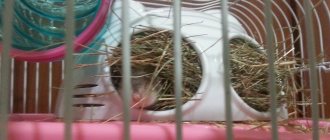- home
- Care
18.07.2018
A hamster is a clean pet that delights everyone. But not all owners of these animals know that it is possible to make a special toilet for a hamster.
Possible difficulties
Sometimes it happens that the owner did everything according to the rules, bought a good litter and a tray, but the rodent uses the restroom for other purposes, setting up a storage room or recreation area.
The reasons for a hamster sleeping in a tray are commonplace - he does not have or. Sometimes hamsters store food in the toilet, since there is little space in the cage and there is no other pantry. There is another side to the coin: the rodent ignores the toilet and sets it up in the house for sleeping. This becomes a real problem, because the baby sleeps and sometimes stores in one place. To wean your hamster from going to the toilet in the house, remove it for a while. But if the homa is too attached to his home, he may become hysterical after you clean the house
It is important to wash the house thoroughly so that no traces of urine remain on it.
There are several reasons why a rodent won't go to the bathroom. Perhaps he has a very large cage and has allocated several corners for urine. Watch your baby, this will help you figure out all the places where he relieves his natural needs. There is no point in punishing him - this is unnecessary stress that will not lead to results. It is better to buy several toilets and place them in the corners that the animal has chosen for defecation. Very soon he will understand what they are intended for.
Remember, toilet training is a labor-intensive process that requires an individual approach.
How to set up a toilet and train your hamster to use it
Choosing a cage for a Djungarian hamster
How to make a drinking bowl for a hamster
Now there are several types of toilet corners from different manufacturers on sale. They differ in the plastic from which they are made, in size and slightly in shape. Most of them have some kind of attachment for attaching to the corner of a cage or aquarium. However, if there is some financial limitation, then even a metal lid from a jar of pickles can be used as a toilet corner. To fill the toilet corner, it is good to use compressed sawdust or corn filler. They absorb well, retain odor and are safe for the hamster.
Subtleties of the process of raising a dzhungarik and unpleasant moments
What to do if the hamster is not yet accustomed to being handled - where to start?
Training a hamster takes time and patience. Don't rush or skip any stages of getting to know your pet. The most important thing is to earn the animal’s trust and not give it reasons to be afraid of you.
If you need to pick up an untrained rodent, for example, to clean the cage, then you can use a bowl or pipe, closed on one side, which is placed in front of the hamster and the animal is driven into it. Out of curiosity, he may climb into it himself.
If this method does not work or your hamster bites very hard, use gloves or a towel.
It is necessary to act very carefully, since this method can cause severe stress in the rodent and make it difficult to further accustom it
What to do if the animal bites
There are several reasons why a hamster might bite you:
- Excessive curiosity. The rodent simply explores everything around and tastes it, and your fingers can also be studied in a similar way.
- Foreign odors coming from hands. If your fingers smell like dried apricots or nuts, your pet can easily confuse them with a treat.
- Perception of you as an aggressor. If you force him out of the cage and chase him with your hand, the hamster will be afraid of you, and biting will be his defensive reaction.
Djungarian hamsters are small in size and have poor eyesight and rely mainly on smells and your voice. That is why before interacting with your pet, you must thoroughly wash your hands with soap to get rid of excess odors. Otherwise, the hamster may bite you by mistake.
Another reason why a rodent may bite concerns pregnant and lactating females. During this period, they experience a hormonal change and begin to protect their offspring. Therefore, it is better to stop physical contact with the female at this time, but at the same time you must constantly talk to her affectionately and calmly.
Pay attention to your hamster's behavior and try to figure out why he is biting. This will allow you to avoid similar situations in the future.
How to properly pick up a dzhungarika?
The Djungarian hamster is very small, so it should be handled with caution. The best way to pick up a hamster is to wrap your palms around it on both sides so that it cannot jump.
This way, you will protect the rodent from possible injury. At first, hold the hamster above a soft surface or not at all high from the floor.
The animal should feel safe while in your hands. Therefore, give him a little shelter by placing him on one arm and covering him slightly with the other. In such a house he will feel calmer.
Toilet train your hamster
So, the structure for the toilet has been purchased, the bedding has also been purchased, it’s time to figure out how to train a hamster to use the toilet. If you simply put a closet in a place chosen by the pet, the animal is unlikely to understand why this booth is needed. It's all about smells here, because the new latrine doesn't smell at all like what it should (that is, the hamster itself and feces). But an animal can be slightly deceived!
Here are instructions on how to train a dwarf to use the toilet (it is also suitable for hamsters of other breeds):
- Notice where your hamster relieves himself and let him remember that location.
- Then place a new closet in that place, pouring fresh filler into it mixed with the one on which the homa has already peed.
- The hamster will come to its usual place and see a restroom there. He can immediately go there and do his business or hang around nearby. In this case, continue the trick with the used filler and wait. Sooner or later, the fluffy will visit the closet.
- If you notice that your pet has used the toilet, use mixed litter for another week, reducing the proportion of litter used daily. This is the consolidation stage.
- Soon the hamster will recognize the restroom not only by smell, but also visually. From now on, when cleaning, put only clean litter in the toilet.
Of course, there are rodents that do not want to get used to the latrine. But such fluffies are rare, because hygiene is the second “I” of hamsters!
If you can train your furry friend to go to the bathroom, it will have a positive effect on his health. In addition, the hamster's house will not smell of urine, and general cleaning will be required less often. When training a fluffy, the main thing is to have patience and follow all the steps consistently.
Instructions
Next, you need to choose one of the options for special toilets, which can be found in a wide range in pet stores. Any dish with low sides can be used as a toilet. You can also make a toilet for a hamster. When assembling a toilet yourself, you need to choose a material that cannot be chewed through and that will not absorb unpleasant odors.
Before installing the hamster litter box, you should thoroughly rinse the cage. The new toilet should be filled with the required amount of special litter, adding several pieces of litter soaked in your pet's urine. This is done so that the hamster is not afraid of the new structure with strange granules and immediately understands its intended purpose. If the hamster begins to chew on the litter granules, it must be replaced with another type that the hamster does not like. Sawdust can also be used as a filler, but it will have to be changed more often.
After correctly installing the toilet for your hamster, you should pay attention to whether he has started using it. If the pet chooses a different place to urinate, the toilet should be rearranged, and, if necessary, one or more toilets should be added to the cage
If before installing the toilet, the hamster relieved itself in the house, then when installing the toilet, the hamster's house should be temporarily removed from the cage.
Hamsters are popular pets. Children are always happy to have such an animal: it is small in size, does not take up much space, can always be taken with them and is not removed so often. But a small disadvantage of such cute creatures is that their urine smells strong. Therefore, many people begin to think about how to toilet train a hamster.
Choosing a place for the closet
Don’t know where to put the “thoughtful corner”? Then ask your furry pet about it. Of course, you will not receive a verbal answer, but observations of the animal will tell you.
During the first days of being in your house, the homa, in a state of stress, will shit everywhere. Then he will calm down a little and understand that he has to live in this place. He will begin to take care of his new home - and first of all, about its sanitary and hygienic condition. A week after getting used to the home, you will notice that the hamster has chosen a place for himself to relieve his needs. This is where the toilet will be located.
Usually rodents do their dirty deeds in one of the corners that are located away from the bowl. In fact, a corner is a great place for a closet. But sometimes there are 2-3 such places. And some hamsters have a hard time adapting to a new place of residence, so they practically never leave the mini-house and shit right there. In this case, donate that house to the animal, since the homa is already used to relieving himself there.
But now the animal begins to “go to a certain address”, what should be the next step? Of course, the choice of a building that will stand in a treasured corner.
Why doesn't the hamster go to the toilet?
Not every rodent can be toilet trained. But in most cases it can be done. Sometimes it takes more time to train him to go to the toilet. So that the hamster understands what you want from him, what you are hinting at. If the cage is large or has several sections and floors, the rodent may simply have several toilets. In this case, you look at specific places in the cage where he urinated. They will be the same every time you clean the cage. Just place one toilet for each place identified by the rodent. This should solve the problem. This method can be used when the hamster does not want to go to the toilet, which is placed in the place of his toilet. He will find a new area, then we put the prepared container there too. And so on until he chooses one of them, then the others can be taken away. The reason that the hamster does not get used to the toilet may be poor quality. It may not be convenient, the entrance does not suit the rodent, or the material is poorly selected.
In order for the little friend to bring exceptional pleasure from communication, the owners will need to train the hamster to use the toilet.
This process will not take much time and effort, since these rodents themselves are particularly clean.
With proper care, the hamster's cage will not emit an unpleasant odor, so frequent cleaning will not be required.
The choice of accessories for caring for rodents is quite wide. The most common material from which latrines are made is plastic. It is practical to use and inexpensive.
The main disadvantage of a plastic toilet is that the hamster can start chewing the product.
Given this feature, it is important to ensure the quality of the product, since a hamster may have an allergic reaction to a low-quality plastic product. If you have any doubts about the quality of the material from which the restroom is made, it is better to ask the seller for the appropriate certificate. To choose the right toilet, the owner needs to be guided by the following criteria:
- Sustainability. In order not to discourage your hamster from visiting the restroom, you need to choose a product that will not tip over during use.
It is better to give preference to a design with hooks that are attached to the cage. - Entrance size. Toilets of appropriate sizes are provided for different breeds of rodents. The width of the entrance should also be suitable. For example, for Syrian hamsters the entrance to the toilet should be at least twice as large as for Djungarian hamsters.
- Design. It is better to choose a toilet consisting of two parts - a tray and a top part,
since a one-piece product is more difficult to clean. - Form. Here the breed of the rodent also matters. Any shape is suitable for the Djungarian hamster, and square or triangular for the Syrian.
They include a filler, a miniature shovel for removing waste products, and the “room” itself to satisfy the natural needs of the rodent.
Prices for toilets vary, so the hamster owner will be able to choose a product that suits his pocket. The final cost of the toilet is influenced by the material from which the toilet is made, the design and the brand.
The most popular manufacturers of accessories for rodents, which have proven themselves well:
- Savic hamster toilet.
A toilet with two rectangular entrances. Considering the dimensions (length - 17 cm, height of the side at the entrance - 4 cm), it is more suitable for Syrian breed hamsters. Price - from 600 rub. - Trixie. Triangular shaped toilet (without lid). Suitable for Syrian hamsters (triangle base length - 16 cm). Price - from 100 rubles.
- Ferplast Koky (set). An oval-shaped toilet made of two components. Made from non-toxic material. The set also includes a cleaning shovel and filler. Suitable for Syrian hamsters (size - 18 cm). Price - from 450 rub.
- Super Pet (set). Design of two parts, oval shape, blade, filler. Suitable for both Syrian and Djungarian hamsters (size - 14 cm). Price - from 500 rub.
What to look for when purchasing
Not every pet store can boast a wide range of closets for hamsters.
Despite this, it is necessary to consider some points when choosing a toilet:
- Product size and entry width. These parameters depend on the size of your pet. For Djungarian hamsters, the smallest ones are suitable, but for Syrian ones, two to three times more are needed.
- Form. The product should have a triangular or square base if you have a Syrian hamster. For Dzungarians, any will do.
- Design. The most practical products are of a collapsible design (pallet with a top part).
- Material. As a rule, pet stores offer plastic closets for hamsters. Check that the material is of high quality and certified.
- Sustainability. The toilet must be stable so that the hamster cannot knock it over. It is advisable that the product have hooks for attaching to the grill.
How to stop a hamster from peeing in the house?
Some rodents refuse to visit the toilet, choosing a house for their “business”. To wean him from this harmful habit, it is enough to remove the house from the cage for a while. However, this can cause stress for the animal.
Another option is careful hygiene of the hamster’s house, aimed at eliminating the smell that attracts the animal and encourages it to relieve itself in a specific place.
If the cage is too large for the hamster, he may pee in several places at once. In this case, an additional toilet may be needed.
Following these simple rules will not only make caring for your rodent easier, but will also preserve its health.
Requirements
The main criteria when choosing a cage are its comfort and safety for your pet. In addition, the future home of a furry friend should be comfortable for its owner. The owner needs to select in advance the place where the new home will be located, and also select a product for a certain size, no less than the minimum recommended for a dzhungarik.
The materials from which the cage is made must not only be durable and strong, but also safe. Rodents taste everything they see, so the grill bars they try should not be harmful to the health of the animal.
Choose a cage that is easier to clean. It is more convenient to buy a product with a pallet. Be sure to check that the door closes well.
Djungarians are very curious creatures, prone to escape, and a weak locking device may not withstand its sharp teeth. Try to buy a home with built-in attributes in advance. This will be a more economical option, and in the future you won’t have to think about where and how best to install all the additional devices.
Materials
Pet stores offer several options for hamster cages.
Made of metal rods. A good ventilated home in which the rodent feels quite comfortable. The inconvenience is that the noise the hamster makes can be clearly heard through the bars, and dirt always forms around. Filler and debris easily penetrate through the bars. The grill itself should be made of high-quality solid metal.
Do not take products made of copper or aluminum - the animal gnaws everything, so it will quickly render such rods unusable.
Plastic or glass aquarium. In such a closed home, the noise level is significantly reduced, and there is almost no garbage. In addition, this is the safest option for a home where there are cats - it is unlikely that a predator will get to the rodent, which is kept in an aquarium under a breathable mesh. However, the hamster himself will be uncomfortable in such a home, since it does not allow air to pass through well.
The inconvenience for the owner is that the aquarium is difficult to clean.
Lattice cage with plastic tray. This is the most preferred option. This cage is easy to clean. If the home is two-level, and the “floor” of the second floor is made in the form of a lattice, then check whether the pet is injured by getting its paws or abdomen stuck between the bars. If the risk of injury is high, cover the second level with cardboard.
It is recommended to buy cages in which the second floor is made of plastic and reinforced with high quality. Try to avoid wooden elements in the cage, as wood absorbs unpleasant odors and also becomes a favorite material for grinding down the rodent's incisors.
Designs and sizes
The length of the cage for one dwarf hamster should be at least 50 cm. This is even longer than for a Syrian hamster. And although the Syrian is larger in size than the Djungarian, the miniature pet still has to run a greater distance per day, so it needs a more spacious cage. If the cage is purchased without additional equipment, then do not forget that the area will be reduced due to the established mandatory attributes.
Another important point when choosing a cage is the gap between the rods. It should be no more than 10 mm.
Give preference to a cage with horizontal bars - rodents like this shape more, and it is much easier to attach additional devices to a horizontal grid for a comfortable life for a rodent.
If the distance between the rods is greater, the hamster will definitely try to escape. And even if the cage contains a fairly well-fed individual, this factor does not deprive it of its plasticity.
If you purchase a very spacious cage, then do not forget that cleaning the hamster is done quite often, and the large dimensions of the cage will significantly complicate this process.
However, if the owner keeps several hamsters at once and plans to breed them, then it is better to opt for a large cage. It is worth mentioning separately about the day of the dwelling. It can be with a retractable mechanism or high. A retractable bottom is much more convenient in terms of cleaning, but a cage with a high bottom is suitable for breeders, since the high sides will prevent curious little hamsters from falling out of the cage.
Do-it-yourself restroom for rodents
Hamsters don't go to all toilets
Many people are interested in how to make a toilet for a hamster with their own hands. It's actually very simple. The main thing is to follow the instructions. The first thing you need to do is find some small, durable plastic container. Calculate its size correctly, the hamster should climb into it without any problems. After you find a container, you will need to make a hole in it; its dimensions should be 6-7 cm. Sometimes hamsters are large, so you can adjust the size of the hole.
The hole should be 2.5-3 cm higher from the floor, so that later you can pour thyrsa or another substitute that you will use inside. If this is not a hamster, but a chipmunk (they are also called dwarf hamsters), then this hole should be located at a height of 1 cm, maximum 1.3 cm. In addition, thanks to this “barrier” the hamster will not fly out droppings, and the entire cage will then it will be clean. The trough must be cleaned every day, as it was said earlier, rodents are very clean creatures, so if it is dirty, they will not go into it.
And, of course, do not forget that the hole must be secured. To do this, sand the hole and, best of all, protect it by covering it with some soft and light cloth.
Glass restroom
In fact, a glass toilet is much easier to make than a plastic one. To do this you will need:
- small glass jar 500 - 250 ml, depending on the size of your pet;
- natural glass cleaner.
Place the jar in a corner and that’s it: pour bedding from the cage there and wait for the hamster to go explore a new object in the house. This device is not difficult to clean, and it turns out to be a fairly budget option.
But before you put the jar in the cage, rinse it well, since rodents have a habit of testing new objects for taste and, if there are traces of chemicals or other substances, the animal may have serious health problems. And of course, try to secure the jar somehow safely so that it doesn’t roll around the house with the hamster.
The important part is the filler
After the choice is made, you need to understand which filler is best to choose. Experts advise that it is best to purchase cat litter for this purpose, odorless cat litter - wood.
This filler absorbs odor well and the animal will not be able to spread it throughout the house. And that’s it – the job is done, once every few days remove the already dirty filler and wash everything, preferably without any chemicals. It is very easy to accustom an animal to such a device.
Toilet replacement
Due to the fact that the toilet is homemade, it will need to be changed from time to time, since the plastic absorbs the smell of urine, the hamster immediately begins to chew on the object, and this can have a bad effect on the health of the animal.
Unfortunately, being chewed is the fate of almost all plastic things that you put in a cage. That is why many experts and already experienced breeders of such pets recommend immediately looking not for plastic vessels in order to make such a “room” out of them, but for glass ones. Then you don’t have to worry about replacing the item, and besides, it will be much easier to wash it, since the smell and dirt won’t stick to the glass so much, and the animal, no matter how hard it tries, won’t be able to chew it off.
Nonsense or normal?
General cleaning of a hamster's apartment should be done at least once a week. During this time, the litter is already saturated with portions of urine, bacteria quickly multiply in it, and it begins to smell unpleasant. Neither the hamsters themselves nor their owners like this. If the furry's cage is very small, then it needs general cleaning twice a week. But every day you have to scrape the hamster poop out of it.
To prevent life from turning into a complete spring cleaning, you can try to teach the nimble animal to fulfill its natural needs in a certain area and even put a small closet in that place! Do you think this is a joke? Don't rush to such a conclusion. A toilet for a hamster is not nonsense, but a completely normal occurrence. After all, cleanliness is the norm for these neat animals.
If your pet learns to go to the toilet, then:
- you don’t have to look for wet bedding and feces throughout the cage; it will be enough to empty the contents of the closet into the trash every morning;
- as a result, the cage will not smell unpleasant;
- the interval between general cleanings can be extended from 7 days to 10;
- the hamster will walk on dry bedding, which will reduce the risk of catching a cold several times;
- pathogens will not multiply as quickly.
You see what a useful thing the hamster closet is! To implement the idea, you should study information on how to make a toilet for a hamster with your own hands, or buy it in a store if you don’t have time for construction. You also need to familiarize yourself with the recommendations for choosing a place and filler.
How to make a second floor in a cage?
The second floor in a hamster cage is additional territory, which means joy for the pet. You can also do it yourself.
To do this you will need roll sticks, a marker, wire, a ruler, wire cutters, and a heat gun.
- We measure the length and width of the planned site.
- We adjust the Chinese sticks to the size of the platform using wire cutters.
- We leave two sticks of standard length, they will be load-bearing.
- We place two cut sticks on one and the other edges transversely, and lay the rest horizontally on them.
- Using glue we connect the structure.
- When the platform is dry, we place it in a cage on supports and secure it with wire around the entire perimeter.
How to make a toilet for a hamster with your own hands
You don’t have to buy a toilet for your hamster in a store. You can do it yourself.
How to make a toilet for a hamster with your own hands: video
Tools and materials
Required (option No. 1):
- plastic container for cottage cheese;
- scissors;
- marker or felt-tip pen for marking.
Required (option No. 2):
- glass salad bowl with a triangular base and two straight sides and a semicircular third;
- plastic bottle (6 l);
- scissors;
- glue gun
Step-by-step manufacturing process
Manufacturing (option No. 1):
- We take the container and, on its two adjacent sides from the outside, use a marker to draw arcs connecting the opposite corners on each side so that the result is a semicircle. Its lower point should be at a distance of a centimeter from the bottom of the container.
- Cut the container along the drawn line.
- We fill the finished toilet with filler.
Manufacturing (option No. 2):
- We cut out a semicircle from the eggplant, the radius of which is equal to the length of the side of the salad bowl.
- We attach the semicircle with a glue gun inside the salad bowl to the sides that form an acute angle.
- We fill the closet with filler.
As you can see, installing a toilet in your hamster’s cage will greatly facilitate the cleaning process. But until the animal gets used to doing its business in the right place, you need to be patient. Follow all the described steps consistently, and a positive result will not take long to come.
Animal training
How to make a toilet for your hamster is already clear. But here’s what to do if the animal doesn’t go there. Check that you have installed the device exactly in the place where the hamster usually goes to urinate.
Once you have the unit at the correct angle, pour clean and dirty litter into it. As soon as the rodent starts crawling around the house or he has just woken up, then place him right in front of the toilet so that he can smell it and understand that now he needs to go there.
Sources:
https://pets2.me/bok/1464-tualet-dlya-homyaka-kakoy-luchshe-vybrat-kak-samostoyatelno-sdelat.html https://homjakam.ru/uhod/tualet-dlya-homyaka https:// slonvkvartire.ru/homyaki/kak-priuchit-k-tualetu.html
How to do it yourself?
You can go the other way and make a toilet for your hamster with your own hands. There are several options, all of them are budget-friendly and easy to implement.
Methods for making a toilet for a hamster:
- Jar. The simplest and most inexpensive option for the toilet may be a small glass jar. It is enough to pour filler into it and place it in a suitable place.
- Plastic container. In order for a food container to become a toilet, you need to cut a hole in it for entry. For a Syrian hamster, the size of the hole must be at least 7 cm in diameter, and for a Djungarian hamster - 5 cm. The edges of the resulting entrance must be processed to avoid injury to the pet. To do this, you can use a lighter or sandpaper.
- Cardboard box. A cardboard milk or juice bag is best suited for these purposes. The manufacturing procedure is the same as with a plastic container. The main disadvantage of such a toilet is its fragility. However, you can make several blanks in advance and change them as needed.
Model overview
Toilets from the following manufacturers are considered very practical, comfortable and stylish:
- Trixie (corner without roof). The simplest model you can imagine is similar to a baby potty J. The size is quite large (16 cm - the base of the triangle), so it is suitable for a Syrian hamster. Cost – from 100 rubles.
- Super Pet set. An oval plastic box of 2 parts, the set also includes a bag of filling and a special scoop. The length is 14 cm, so this closet is suitable for both Dzungarians and Syrians. The price of the set is 500 rubles.
- Savic hamster toilet. Rectangular closet with two entrances. Its length is 17 cm, the entrance is located at a level of 4 cm, so such a latrine will not suit a Djungarian, but it will be just right for a Syrian. The price is a little steep, considering that this is not a set - 600 rubles.
- Ferplast Koky set. Externally similar to Super Pet, it also contains filler and a spatula, but is slightly longer in length (18 cm). Made of non-toxic material, costs 450 rubles.
In online stores you can also find more original models, for example, cute round toilets for dzhungariks.
How to make a hamster litter box yourself
If you didn’t find a suitable option at the pet store, you can make such an accessory yourself. Making a toilet with your own hands is quite simple. All you need is a plastic box with a lid.
It is necessary to pay special attention to the analysis of the quality of plastic. It should not break easily and be too light
It is necessary to cut a hole for the entrance. To determine the size of the connector, you should look at the size of the pet. The entrance should not be small, but not very large either. You should also not cut the hole very low, otherwise feces will fall into the cage and there will be no point in such a tray. If the toilet is made for a Djungarian or other small hamster, then it is worth retreating 1-1.5 cm from the bottom. In cases where the rodent is larger, then it is worth retreating 2-2.5 cm.
Particular attention should be paid to processing the cut edge. The pet should not cut itself or get caught on the untreated cutout
This can cause damage to his body or paws.
If your pet starts chewing on a plastic toilet, you should replace it. Therefore, you can use glass instead of plastic. Any jar with a wide mouth will be suitable for this purpose so that the hamster can climb into it. This option is much simpler, because there is no need to cut out the input and output connectors. It is enough to take a regular jar. The size of the container also depends on the size of the animal - 250 or 500 ml. The jar needs to be secured well. It should not roll around the cage, otherwise the rodent will refuse to use it.
https://youtube.com/watch?v=c5wooEcmhcU
The toilet needs to be cleaned every day. This is very easy to do - just shake out all the contents into the trash. Full cleaning can be done just once a week. Cleaning one container is much easier than cleaning up feces and urine throughout the cage.
For filler, bedding made of any material is suitable, but it is better not to choose sawdust and shavings. They get wet very quickly and do not guarantee cleanliness.
If your pet learns to go to the right place, this will make cleaning much easier and reduce the likelihood of illness. This way he will not walk on wet bedding and will feel much more comfortable. Rodents love order and are clean animals.
Selecting filler
The litter in the toilet should absorb liquids. It’s good if it consists of completely natural materials. But veterinarians do not recommend using hay for these purposes, because it increases the smell of urine.
In order not to make a mistake, you can consult with a veterinarian or pet store sellers. They usually recommend the following fillers:
- Lauron. Corn bedding that will not cause allergies in a tiny animal. This filler is economical and inexpensive: a 5-liter bag will last for 2 months (if scattered throughout the cage), and it costs about 140 rubles;
- Cat's Best Universal. Suitable not only for pussies, but also for small rodents. This wood filler perfectly absorbs urine and locks in odors. It is also very economical and decomposes quickly. True, it is a little expensive: 400 rubles for 7 liters;
- Clean paws. Small wood pellets. 60 rubles for 4 l;
- Clean Waka. Wood litter, which is produced specifically for small rodents. It does not prick the paws, absorbs urine well, and does not allow odors to spread. 50 rubles for 2 liters.
Please note that stores also sell flavored fillers. So, such bedding is not suitable for a small hamster, as it can cause allergies.











